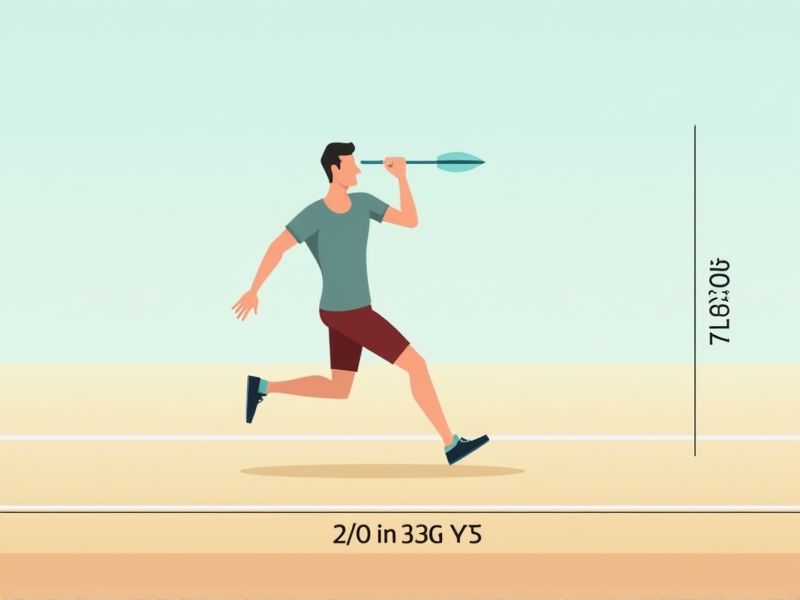
The standard dimensions of a javelin runway are crucial for ensuring fair and safe competition. According to World Athletics regulations, the runway should be 30 to 36.5 meters long and at least 4 meters wide. The runway must be clearly marked, with a throwing arc at the end that has a radius of 8 meters. These dimensions help athletes gain adequate speed while providing enough space for proper technique and safe throws.
Runway Length: 30-36.5 Meters
The javelin run requires a runway length ranging from 30 to 36.5 meters to ensure optimal performance and safety. This designated distance allows athletes to build the necessary speed and momentum before releasing the javelin. Compliance with these measurements is crucial for proper technique and adherence to international competition standards. Proper runway length significantly enhances your chances of maximizing throwing distance.
Runway Width: 4 Meters
The standard runway width for javelin competitions measures 4 meters, ensuring athletes have sufficient space to gain momentum before their throw. This specific width is designed to accommodate both elite and amateur throwers, allowing for optimal performance. You can benefit from understanding that a well-prepared runway can significantly impact your technique and overall distance achieved. Adhering to this regulation is crucial for ensuring consistency and fairness during competitions.
Javelin Arc: 8 Meters Radius
The standard javelin run emphasizes the importance of the javelin arc, which should maintain a radius of 8 meters for optimal performance. This arc is crucial for athletes as it influences the trajectory and distance of the throw. Proper execution within this radius can enhance your throwing technique and increase your competitive edge. Training to master this radius can significantly impact your results in competitions.
Throwing Line Width: 7 Centimeters
The standard throwing line width for javelin runs is set at 7 centimeters, ensuring precision and uniformity in competition. This specified width plays a crucial role in maintaining fair play and consistency among athletes during events. Adhering to this measurement helps officials accurately determine fouls and valid throws. You should note that any violation of the throwing line width may result in disqualification of the throw.
Supplementary Markings: 4-5 Meters From Runway Start
The standard for javelin run practice emphasizes the importance of supplementary markings, which should be placed 4 to 5 meters from the start of the runway. These markings serve as crucial reference points for athletes to enhance their run-up consistency and approach speed. By aligning your starting point with these markings, you can optimize your throwing technique and improve overall performance. Ensuring these supplementary aids are visible and well-maintained can significantly contribute to effective training sessions.
Surface Material: Non-Slip Synthetic Material
The standard for javelin runways emphasizes the use of non-slip synthetic materials, which enhance athlete safety and performance. These materials ensure optimal grip and stability, allowing for maximum acceleration during the run-up phase. A well-constructed runway typically measures 30 meters in length, providing athletes with adequate space to build speed, while the surface's texture contributes to reduced risk of slips. For your next competition, ensure that the javelin runway adheres to these specifications to meet international standards and promote fair play.
Approach Angles: Approximately 40 Degrees
The javelin throw requires a precise approach angle, ideally around 40 degrees, which significantly impacts the distance achieved. Athletes typically run at a speed of 7 to 10 meters per second during their approach, optimizing their momentum for a powerful launch. Mastering this angle helps maximize the javelin's aerodynamics and trajectory, crucial for achieving optimal performance. Understanding the biomechanics involved in your run-up can greatly enhance your throwing technique and ultimately your success in competitions.
Sector Lines: Extend From Throwing Arc
The javelin throw adheres to specific sector lines that extend from the throwing arc, creating a designated area for valid throws. This sector typically opens up to an angle of 29 degrees, ensuring that all throws land within the designated boundaries. To achieve optimal performance, athletes must focus on their approach speed, technique, and angle of release, as these elements can significantly impact throw distance. A successful throw will not only cross the sector lines but also land beyond the minimum requirement of 30 meters for competitive events.
Runway Gradient: Maximum 1:1000 Slope
The javelin runway gradient must adhere to a strict maximum slope of 1:1000, ensuring optimal performance and safety during competition. This standard is critical for maintaining consistent acceleration and stability as athletes approach the throwing line. A properly designed runway enables athletes to achieve maximum speed and distance, enhancing the overall quality of the event. By complying with these guidelines, you can help ensure that the javelin throw meets International Athletics Federation regulations.
Safety Zone: Minimum 50 Meters Past Sector
In javelin throw competitions, the Safety Zone is critical for ensuring athlete and spectator safety, requiring a minimum distance of 50 meters beyond the end of the landing sector. The landing sector itself is typically an angle of 29 degrees, designed to contain the javelin's trajectory. Athletes must also adhere to proper run-up techniques, which should be conducted on a runway measuring no less than 30 meters in length. Strict compliance with these regulations is essential to maintain safety standards during events.
